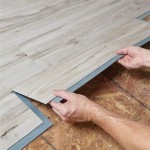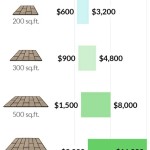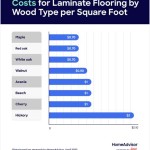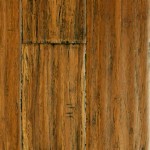Does Laminate Flooring Cause Health Issues? An In-Depth Examination
Laminate flooring has become a popular choice for homeowners seeking an affordable and aesthetically pleasing alternative to hardwood. However, concerns have arisen regarding the potential health effects associated with laminate flooring, particularly concerning the release of volatile organic compounds (VOCs) and the presence of formaldehyde. This article will explore the evidence surrounding these concerns and examine whether laminate flooring poses a genuine risk to human health.
Laminate flooring is a synthetic product composed of multiple layers fused together. Typically, these layers include a high-density fiberboard (HDF) or medium-density fiberboard (MDF) core, a decorative photographic layer, and a protective wear layer. The HDF or MDF core is often bonded using resins, some of which contain formaldehyde. Formaldehyde is a known irritant and carcinogen, and its release from building materials has been a long-standing concern for indoor air quality.
The primary concern regarding the health effects of laminate flooring centers on the emission of VOCs, especially formaldehyde. VOCs are organic chemicals that evaporate at room temperature, and their presence in indoor air can contribute to a variety of health problems. These problems range from mild irritations of the eyes, nose, and throat to more serious respiratory issues and even potential carcinogenic effects with prolonged exposure. The type and concentration of VOCs emitted from laminate flooring can vary significantly depending on the manufacturing process, the types of resins used, and the age of the flooring.
Formaldehyde Emission and Regulatory Standards
Formaldehyde is a naturally occurring chemical that is also widely used in industrial manufacturing. It's a key component in the resins used to bind the wood fibers in the core of laminate flooring. The amount of formaldehyde emitted from laminate flooring is regulated by various standards, aiming to limit potential health risks. In the United States, the California Air Resources Board (CARB) has established stringent formaldehyde emission standards for composite wood products, including laminate flooring. These standards, known as CARB Phase 1 and Phase 2, set maximum formaldehyde emission levels. Laminate flooring products sold in California, or even nationally due to market pressures, are generally required to meet these standards.
The European Union also has comparable standards, such as the E1 standard, which limits formaldehyde emissions from wood-based products. Manufacturers who adhere to these standards use lower-emitting resins or implement processes to reduce formaldehyde emissions during manufacturing. Compliance with these standards is generally indicated on the product packaging or in the product specifications.
It is crucial to note that even laminate flooring that meets these standards may still emit some formaldehyde, although the levels are considered to be within a safe range for most individuals. However, individuals with sensitivities to formaldehyde or those who are particularly susceptible to respiratory problems may still experience adverse effects from even low levels of exposure. This highlights the importance of adequate ventilation and choosing low-VOC flooring options whenever possible.
Potential Health Effects of VOC Exposure
Exposure to VOCs, including formaldehyde, can manifest in a range of health symptoms. Short-term exposure may trigger symptoms such as eye, nose, and throat irritation, headaches, dizziness, and nausea. Individuals with pre-existing respiratory conditions, such as asthma or allergies, may experience a worsening of their symptoms. Long-term exposure to elevated levels of VOCs has been linked to more serious health effects, including respiratory illnesses, neurological problems, and an increased risk of certain types of cancer.
The severity of health effects depends on several factors, including the concentration and duration of exposure, the type of VOCs involved, and the individual's susceptibility. Children, the elderly, and individuals with pre-existing health conditions are generally more vulnerable to the adverse effects of VOC exposure. It's also important to consider that VOCs can be emitted from other sources in the home, such as paints, adhesives, cleaning products, and furniture. The cumulative effect of exposure from multiple sources can increase the overall risk to health.
While the regulated levels of formaldehyde in compliant laminate flooring are designed to minimize health risks, it's essential to be aware of potential symptoms and take steps to mitigate exposure. Maintaining good ventilation, especially during and after installation, can help to reduce VOC concentrations. Choosing low-VOC or formaldehyde-free flooring options can also significantly reduce the potential for health problems.
Factors Influencing VOC Emission Levels
Several factors influence the amount of VOCs emitted from laminate flooring. The manufacturing process, the types of resins used, and the age of the flooring play crucial roles. Laminate flooring manufactured using formaldehyde-free resins, such as phenol-formaldehyde (PF) or melamine-formaldehyde (MF) resins, generally emits lower levels of formaldehyde compared to those manufactured using urea-formaldehyde (UF) resins. While PF and MF resins are considered lower-emitting, they may still release other types of VOCs, although typically at lower concentrations.
The age of the flooring also affects VOC emission levels. Newly installed laminate flooring tends to emit higher levels of VOCs compared to older flooring. This is because the chemicals used in the manufacturing process gradually off-gas over time. The rate of off-gassing decreases as the flooring ages, eventually reaching a point where VOC emissions are negligible.
Environmental factors, such as temperature and humidity, can also influence VOC emissions. Higher temperatures and humidity levels tend to increase the rate of off-gassing, leading to higher VOC concentrations in the indoor air. Adequate ventilation can help to mitigate these effects by removing VOCs from the air and replacing them with fresh air. Proper installation techniques, such as using low-VOC adhesives and sealing the edges of the flooring, can also help to reduce VOC emissions.
The type of underlayment used can also impact VOC emissions. Some underlayments may contain their own VOCs, which can contribute to the overall VOC burden in the indoor environment. It is prudent to choose low-VOC underlayment options that are specifically designed for use with laminate flooring.
The source is a critical factor. Some flooring that are sourced from manufacturers that are not reputable or are not compliant with CARB-2 regulations can emit significantly high levels of formaldehyde and other harmful VOCs. Purchasing from well-known manufacturers with a track record of compliance and transparency is crucial.
Ultimately, whether or not laminate flooring causes health issues is a complex question with no simple answer. While modern laminate flooring products generally meet stringent emission standards, the potential for VOC exposure and associated health effects cannot be completely dismissed. Individuals with sensitivities to chemicals or those who are particularly concerned about indoor air quality should take extra precautions to minimize their exposure. Choosing low-VOC flooring options, ensuring adequate ventilation, and maintaining a healthy indoor environment are all important steps in mitigating potential health risks.

A Guide To Repairing Swollen Laminate Flooring Mersey

Disadvantages Of Laminate Wood Flooring Key Drawbacks

The Dangers Of Luxury Vinyl Floors Lvt And How You Can Avoid Them Artisan Wood Llc

Disadvantages Of Laminate Flooring Read This Before Choosing Wood And Beyond Blog

Non Toxic Laminate Flooring Brands Formaldehyde Free My Chemical House

Disadvantages Of Laminate Wood Flooring Key Drawbacks

Do Pvc Floorings Have An Impact On Our Health Netzsch Yzing Testing

Disadvantages Of Laminate Wood Flooring Key Drawbacks

The Dangers Of Luxury Vinyl Floors Lvt And How You Can Avoid Them Artisan Wood Llc

What To Do When Your Laminate Floors Are Raising Flooring Liquidators
Related Posts








